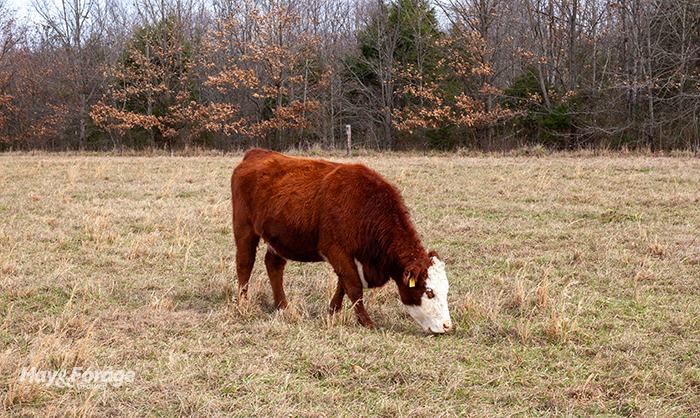
The reality of planning things is that things rarely go as planned. That’s not to say preparation isn’t valuable, though. If a plan can’t be followed to the letter, it can at least provide a starting point to develop a different strategy.
That was the main idea of last week’s National Cattlemen’s Beef Association (NCBA) webinar titled, “Strategic winter grazing: Planning for cold season success.” There’s no guarantee that winter conditions will be suitable for grazing, but there are ways to keep cattle on pasture if farmers are willing to roll with the punches that come with cold and snow.
Johnny Rogers owns Rogers Cattle Company in Roxboro, N.C., and is the program coordinator of North Carolina State University Extension’s Amazing Grazing Program, which is an educational initiative for pasture-based production systems. Before providing webinar attendees with several winter feeding strategies, he offered the basic framework of adaptive grazing management.
Rogers called adaptive grazing a “thinking person’s game.” For a more technical description, he said it is the practice of using proven grazing principles to meet the dynamic, biologic, economic, and social needs of individual operations and their communities. In addition to boosting the profitability and sustainability of a pasture system, adaptive grazing requires farmers to consider the bigger picture.
Many adaptive grazing decisions are based on carrying capacity and stocking rate. After determining what a pasture’s carrying capacity is, Rogers suggested applying a stocking rate that is slightly below that. “The challenge with carrying capacity is that it changes,” he said, and a lot of these changes occur with inclement weather, especially drought.
In addition to the number of livestock that represent a stocking rate, Rogers encouraged farmers to ensure the quality of those animals by measuring gains and performance. For cow-calf operations, he said the number one metric for optimal herd efficiency is pounds of calf weaned per cow exposed. Average cow weight is another important attribute since animal size can impact forage utilization.
“Know how big your cows are because that affects the stocking rate that you’re trying to marry with your carrying capacity,” Rogers said. In an industry that has historically focused on raising animals to maximize income, he encouraged farmers to instead take a look at their cows’ greatest expenses. These include total feed costs and less-than-ideal reproduction traits.
Three feeding options
Unrolling bales is one of the most popular winter feeding strategies, Rogers said. Although some farmers may be wary of wasting hay, he argued that the nutrients left behind from unrolled bales can benefit soil fertility. Even so, the best strategy for this system is unrolling only a day’s worth of hay at a time, which won’t work for everybody’s schedule.
Bale grazing is another solution for winter feeding that offers more flexibility. During the webinar, Rogers demonstrated how to set up bales in advance and use temporary fence to open up access to new bales across the field over time. He called the process a “concentration of labor,” requiring more effort upfront, but less work day-to-day. This also translates to less equipment use and traffic in winter pastures, and Rogers noted bale grazing has shown to enhance nutrient distribution from livestock compared to unrolling bales.
With that said, Rogers admitted his bias to stockpiling tall fescue. “My favorite winter grazing practice is using stockpiled forages,” he said. Considering his fall-calving herd, stockpiling provides high-quality forage when his cows hit their peak energy demands in late fall and winter. For farmers located outside of the Fescue Belt, Rogers said bermudagrass also has stockpiling potential, and he recommended applying nitrogen to both species in the fall to help extend winter grazing.
Notes from up North
Following Rogers’s presentation, Rachel Gray joined the webinar to discuss winter grazing in a more frigid environment. Gray and her family raise and develop bred heifers at Little Timber Farms in Blackduck, Minn., which is about 60 miles south of the Canadian border.
Gray said winter grazing is a must for their operation given the length of their cold season and the amount of snow their farm receives every year. She emphasized that planning is key for successful winter grazing, and a good winter grazing plan begins in the summer.
Everybody takes notes at Little Timber Farms, whether they are walking through pastures or checking cattle in the side-by-side. The family constantly keeps records on summer forage growth, species distribution, and soil fertility to prepare for winter pastures. The Grays also prioritize soil testing, performing infiltration tests, and assessing soil biological activity to ensure the longevity of their forage system.
Like Rogers, Gray advocated for extending the fall grazing season, which she does by utilizing cover crops, interseeding pastures with annual forages, and stockpiling forage. She also unrolls bales and bale grazes, dedicating “roll out” areas for unrolled hay and having specific placement areas for bale grazing to minimize pasture disturbance and optimize nutrient distribution.
Even though temporary electric fence is an asset in her summer pastures, Gray said using it to divide winter pastures isn’t always an option because snow can get too deep. One type of infrastructure the family does use is temporary windbreaks. Setting up these barriers helps to maintain a relatively clear feeding area and prevents unrolled hay from being buried under snow drifts.
Before logging off, Rogers encouraged farmers to meet grazing challenges by continuing to adapt to their environment. “The things we do in our pasture-based livestock operations is very important to our communities and our nation,” he said. “We need to continue to work with each other to learn new practices, learn new ways of doing things, and share what we’ve learned with others.”

